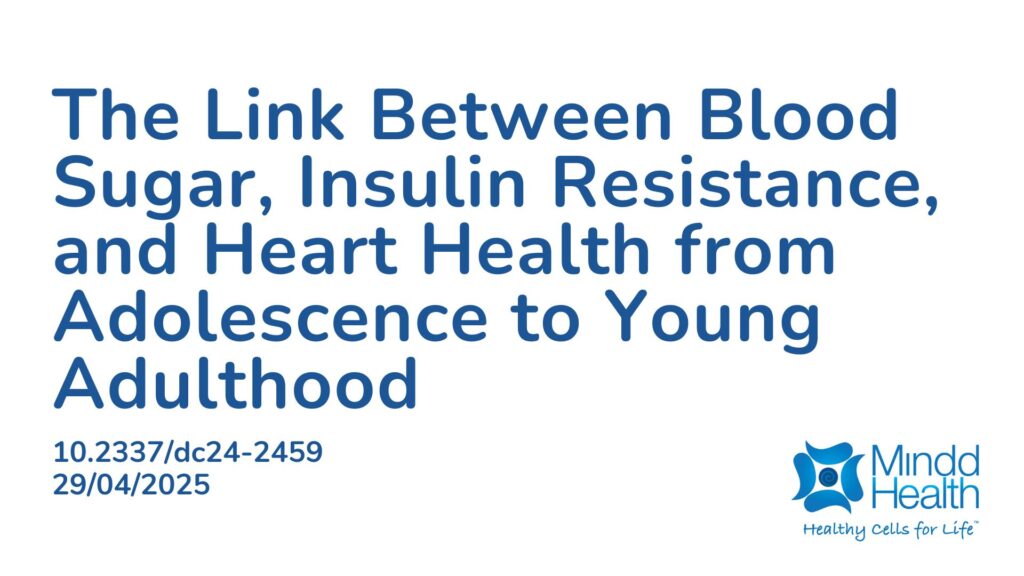Summary:
Insulin resistance (IR) and abnormal blood sugar often precede type 2 diabetes and have been linked to changes in heart and blood vessel structure. Recent evidence suggests that in mid-adolescence, fat mass mainly drives IR. Despite the global rise in young-onset type 2 diabetes, there is limited evidence supporting early screening in youth, especially regarding heart outcomes. It remains unclear whether IR causes early heart changes in apparently healthy adolescents, partly due to a lack of long-term studies with repeated heart imaging. Other factors such as high cholesterol, blood pressure, obesity, smoking, and inactivity may also contribute to early heart changes and often coexist with blood sugar abnormalities. Long-term data are needed to understand how blood sugar and other risk factors impact early heart damage. This study analyzed data from the Avon Longitudinal Study of Parents and Children (ALSPAC) in the UK. It followed 1,595 adolescents from age 17 to 24, measuring fasting glucose, insulin, and heart structure via echocardiography. The prevalence of left ventricular hypertrophy (LVH) rose from 2.4% at 17 to 7.1% at 24 years. Increases in glucose and insulin resistance were linked to increased heart mass over seven years. Persistent high glucose significantly raised the risk of LVH. Increased fat mass explained about 62% of the link between worsening insulin resistance and heart changes. In summary, persistent high blood sugar and rising insulin resistance during adolescence are associated with progressive heart changes and damage, largely driven by increased fat mass.
Abstract:
OBJECTIVE: Insulin resistance (IR) and dysglycemia can induce cardiac remodeling in adulthood, but little evidence exists with respect to cardiac remodeling in youth with and without evidence of new-onset glucose metabolic alterations. This study investigated whether changes in metabolic status from adolescence to young adulthood are associated with the risk of progressive cardiac remodeling and examined potential mechanistic pathways. RESEARCH DESIGN AND METHODS: From the Avon Longitudinal Study of Parents and Children (ALSPAC), U.K. cohort, 1,595 adolescents, mean (SD) age 17.7 (0.4) years, who had data on fasting plasma glucose and insulin levels, and echocardiography left ventricular (LV) mass indexed for height raised to the power of 2.7 (LVMI2.7) and in whom these factors repeatedly were measured at a clinic visit when they were aged 24 years were included. HOMA-IR was computed, hyperglycemia was defined as glucose concentration of ≥5.6 mmol/L and ≥6.1 mmol/L, and LV hypertrophy was defined as LVMI2.7 ≥51g/m2.7. RESULTS: The prevalence of LV hypertrophy increased from 2.4% at baseline to 7.1% at follow-up. Each unit increase of glucose (β = 0.37 g/m2.7 [95% CI 0.23–0.52]; P < 0.001) and HOMA-IR (1.10 g/m2.7 [0.63–1.57]; P < 0.001) was independently associated with increased LVMI2.7 over 7 years. Persistent hyperglycemia of 5.6 mmol/L and 6.1 mmol/L was associated with higher odds (odds ratio [OR] 1.46 [95% CI 1.35–1.47], P < 0.001; and 3.10 [95% CI 1.19–8.08], P = 0.021, respectively) of worsening LV hypertrophy over 7 years. Increased fat mass (62% mediation) significantly mediated the association of increased HOMA-IR with increased LVMI2.7. CONCLUSIONS: Persistent adolescent hyperglycemia and worsening IR were associated with the risk of worsening structural and functional cardiac damage, and these were largely explained by increased fat mass.
Article Publication Date: 29/04/2025
DOI: 10.2337/dc24-2459



